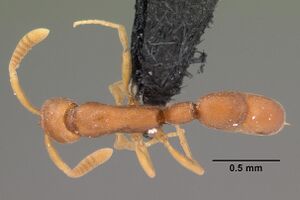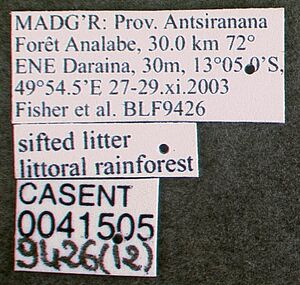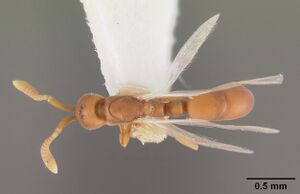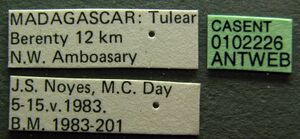Probolomyrmex tani
| Probolomyrmex tani | |
|---|---|

| |
| Scientific classification | |
| Kingdom: | Animalia |
| Phylum: | Arthropoda |
| Class: | Insecta |
| Order: | Hymenoptera |
| Family: | Formicidae |
| Subfamily: | Proceratiinae |
| Tribe: | Probolomyrmecini |
| Genus: | Probolomyrmex |
| Species: | P. tani |
| Binomial name | |
| Probolomyrmex tani Fisher, 2007 | |
Despite that most of the material was collected from leaf litter, P. tani is more likely subterranean in lifestyle, very much like Probolomyrmex curculiformis.
Identification
Hita Garcia & Fisher (2014) - The following character set distinguishes P. tani from its congeners in Madagascar: head in full-face view between 1.5 to 1.6 times longer than broad (CI 64–66); SI 92–103; in profile mesosomal outline flat to very weakly convex, metanotal groove usually absent, but rarely weakly developed; hind tibia around 1.0 to 1.1 times longer than head width (HTLI 100–111); petiole relatively longer, lower, and less arched, in profile (without ventral process) around 1.3 to 1.5 times longer than high (LPNeI 127–150), and in dorsal view around 1.4 to 1.6 times longer than broad (DPeI 63–69).
Probolomyrmex tani is the most distinctive species of the three Madagascar Probolomyrmex. The shape of the petiole alone separates it very well from Probolomyrmex curculiformis and Probolomyrmex zahamena. In these two the petiole is shorter, higher and stronger arched, in profile (without ventral process) around 1.3 to 1.5 times longer than high (LPNeI 127–150), and in dorsal view around 1.4 to 1.6 times longer than broad (DPeI 63–69). By contrast, the petiole of P. tani is relatively longer, lower, and less arched, in profile (without ventral process) around 1.3 to 1.5 times longer than high (LPNeI 127–150), and in dorsal view around 1.4 to 1.6 times longer than broad (DPeI 63–69).
Despite being less variable than previously thought (Fisher 2007), P. tani still displays some noticeable intraspecific variation within a relatively small area in northern Madagascar. The specimens from Makirovana possess a much better developed and conspicuous foveolate surface sculpture than the rest of the material of P. tani. Most of the material from Makirovana also has a small but distinct metanotal groove, which is absent in the material from other localities, and longer antennal scapes (SI 99–102). These dissimilarities could be used to separate this series as different species. However, there are several good arguments against it. The length of the antennal scapes is always stable within localities, but shows some noticeable geographical variation. The specimens from the type locality possess the shortest scapes (SI 92–94), whereas the ones from Makirovana and Ambondrobe have the longest scapes (SI 99–102). However, the material from Binara and Montagne des Français shows intermediate values (SI 94–96). Furthermore, the metanotal groove is extremely weak in one specimen from Makirovana, almost absent. Also, as mentioned above, surface sculpturing is relatively variable in all three Probolomyrmex species. So, consequently, we prefer to keep all the material listed as P. tani as one somewhat variable species.
Keys including this Species
Distribution
Hita Garcia & Fisher (2014) - P. tani is restricted to a narrow strip in the northeast of Madagascar ranging from Makirovana and Ambondrobe north to Montagne des Français.
Latitudinal Distribution Pattern
Latitudinal Range: -12.32277778° to -23.99222222°.
| North Temperate |
North Subtropical |
Tropical | South Subtropical |
South Temperate |
- Source: AntMaps
Distribution based on Regional Taxon Lists
Malagasy Region: Madagascar (type locality).
Distribution based on AntMaps
Distribution based on AntWeb specimens
Check data from AntWeb
Countries Occupied
| Number of countries occupied by this species based on AntWiki Regional Taxon Lists. In general, fewer countries occupied indicates a narrower range, while more countries indicates a more widespread species. |

|
Estimated Abundance
| Relative abundance based on number of AntMaps records per species (this species within the purple bar). Fewer records (to the left) indicates a less abundant/encountered species while more records (to the right) indicates more abundant/encountered species. |

|
Habitat
Probolomyrmex tani is found in a variety of forest habitats, such as littoral rainforest, tropical dry forest, lowland rainforest, and montane rainforest, and has an altitudinal range of 10 to 1100 m.
Biology
Castes
Images from AntWeb
   
| |
| Worker. Specimen code casent0004401. Photographer April Nobile, uploaded by California Academy of Sciences. | Owned by CAS, San Francisco, CA, USA. |
   
| |
| Holotype of Probolomyrmex tani. Worker. Specimen code casent0041505. Photographer April Nobile, uploaded by California Academy of Sciences. | Owned by CAS, San Francisco, CA, USA. |
   
| |
| Paratype of Probolomyrmex tani. Queen (alate/dealate). Specimen code casent0041506. Photographer April Nobile, uploaded by California Academy of Sciences. | Owned by CAS, San Francisco, CA, USA. |
   
| |
| Paratype of Probolomyrmex tani. Worker. Specimen code casent0041507. Photographer April Nobile, uploaded by California Academy of Sciences. | Owned by CAS, San Francisco, CA, USA. |
   
| |
| Queen (alate/dealate). Specimen code casent0102226. Photographer April Nobile, uploaded by California Academy of Sciences. | Owned by NHMUK, London, UK. |
   
| |
| Queen (alate/dealate). Specimen code casent0465467. Photographer April Nobile, uploaded by California Academy of Sciences. | Owned by CAS, San Francisco, CA, USA. |
Nomenclature
The following information is derived from Barry Bolton's Online Catalogue of the Ants of the World.
- tani. Probolomyrmex tani Fisher, 2007: 146, figs. 1-7 (w.q.) MADAGASCAR.
- Type-material: holotype worker, 1 paratype worker, 1 paratype queen.
- Type-locality: holotype Madagascar: Prov. Antsiranana, Forêt d’Anlabe, 30.0 km. 72° ENE Daraina, 13°05’00’’S, 49°54’30’’E, 30 m., 27.xi.2003, BLF9426, CASENT0041505 (B.L. Fisher, et al.); paratypes with same data but CASENT0041506, CASENT0041507.
- Type-depositories: CASC (holotype); CASC, MCZC (paratypes).
- Status as species: Hita Garcia & Fisher, 2014b: 71 (redescription).
- Distribution: Madagascar.
Unless otherwise noted the text for the remainder of this section is reported from the publication that includes the original description.
Description
Worker
Hita Garcia & Fisher (2014) - (N=10). HL 0.56–0.65 (0.60); HW 0.37–0.42 (0.39); SL 35–43 (0.39); WL 0.73–0.91 (0.80); PH 0.25–0.30 (0.27); PW 0.27–0.35 (0.30); HTL 0.39–0.47 (0.42); PeH 0.26–0.31 (0.28); PeNH 0.19 –0.23 (0.21); PeNL 0.26–0.34 (0.29); PeW 0.17–0.22 (0.19); CI 64–66 (65); SI 92–103 (0.98); LMI 33–37 (35); HTLI 100–111 (104); DPeI 63–69 (67); LPeI 97–110 (103); LPeNI 127–150 (137); PeNI 60–66 (63).
In full-face view head between 1.5 to 1.6 times longer than broad (CI 64–66), posterior head margin flat or weakly concave; lateral margins of head convex, broadest medially, posterolateral corners rounded; clypeus and anterior part of frons strongly protruding anteriorly as narrow frontoclypeal, subrectangular shelf or socket; antennal sockets exposed and closely approximated, separated by a thin, vertical lamella formed by fused frontal carinae; mandibles small, triangular to elongate-triangular, masticatory margin armed with one larger apical tooth and a series of six smaller denticles, in full-face view mandibles obscured by frontoclypeal shelf; palp formula 4,2; eyes absent; antennae 12-segmented, funicular antenommeres growing in size and width towards apex without forming well defined antennal club, apical antennomere much larger than remaining funicular antenommeres, antennal scape short (SI 92–103), far from reaching posterior head margin. Mesosoma slender, long, and relatively low (LMI 33–37), in profile mesosomal outline flat to very weakly convex; propleurae enlarged and projecting ventrally; promesonotal suture absent; metanotal groove usually absent, rarely present but very weak; declivitous face of propodeum margined by low, obtuse, and concave lamella on each side, propodeal lamella posterodorsally with small, blunt tooth, posteroventrally with rounded lobe or very blunt tooth; posterior declivity of propodeum weakly concave in dorsal view. Legs long and slender; all tibiae with single, pectinate spur; pretarsal claws simple without median tooth; hind tibia around 1.0 to 1.1 times longer than head width (HTLI 100–111). In profile petiole with subpetiolar process around 1.0 to 1.1 times longer than high (LPeI 97–110), petiole without subpetiolar process around 1.3 to 1.5 times longer than high (LPNeI 127–150), petiolar dorsum strongly arched, much higher posteriorly, anterior face curving smoothly onto dorsum without well developed anterodorsal margin, posterior face vertical and concave, enclosed laterally and dorsally by low, thick carina; in dorsal view petiole around 1.4 to 1.6 times longer than broad (DPeI 63–69); pronotum between 1.5 to 1.7 times longer than petiolar width (PeNI 60–66); subpetiolar process well developed and lamelliform, ventral face weakly concave, anteroventral portion rounded to moderately angled, posteroventral portion sharper and stronger angled, projecting backwards, variably developed, ranging from right angle to a elongate-triangular tooth. Abdominal segment III in profile narrowed anteriorly, broadest posteriorly. Sting well developed and very long. Surface sculpture generally weakly to moderately foveolate overlaying conspicuous very fine, more or less dense, coriaceous microsculpture, foveolate sculpture better developed and more conspicuous on cephalic dorsum and lateral mesosoma than remainder of body. Pilosity strongly reduced throughout and virtually absent, except for few short hairs below frontoclypeal shelf, some longer hairs on mandibles, and some short, fine hairs around metapleural gland orifice. Pubescence whitish, extremely fine, very short, and appressed, present over most of body, funicular antenommeres with such pubescence overlaid by much scattered, much longer, appressed hairs. Colour light reddish brown to darker brown, appendages lighter, yellowish to light brown.
Queen
(mm): maximum and minimum based on all specimens, n = 3, [paratype]. TL 2.4-2.6 [2.6], HL 0.56-0.60 [0.60], HW 0.40-0.47 [0.42], LHT 0.32-0.41 [0.41], CI 67-83 [67], SL 0.33-0.39 [0.39], SI 80-99 [99], WL 0.71-0.80 [0.80], MW 0.32-0.36 [0.34], DPW 0.16-0.23 [0.2], PH 0.27-0.31 [0.28], PNL 0.24-0.29 [0.29], LPI 82-91 [91] PNH 0.19-0.24 (0.20) [0.20], DPNL 0.21-0.29 (0.24) [0.25], LPNI 101-121 (125) [122].
Characters of Probolomyrmex queen as described by Brown (1975:7). General features as in figures. Eyes large (maximum length of compound eye: 0.10-0.12), not convex, situated anterior to the midline of the head. Form of head, mandibles, and petiolar node as in worker. Surface sculpture, pubescence and color developed as in worker. General form of mesosoma as in figure 2. Based on specimen CASENT0102226 from Berenty, wing venation highly reduced, as in previously described species (Taylor 1965).
Type Material
Holotype worker, Madagascar: Prov. Antsiranana, Forêt d'Analabe, 30.0 km 72° ENE Daraina, 13°05'00"S, 049°54'30"E, 30m, 27 Nov 2003, littoral rainforest, (coll. B.L. Fisher et al.) Collection code: BLF9426, specimen code: CASENT0041505, (California Academy of Sciences) Paratypes: 1 worker and 1 dealate queen with same data as holotype but with specimen codes CASENT0041506 (1dQ) (CASC) and CASENT0041507 (1w) (Museum of Comparative Zoology).
Etymology
The specific name is an arbitrary combination, to be treated as a noun in apposition.
Determination Clarifications
Most of the locality data beyond a narrow strip in the northeast of Madagascar ranging from Makirovana and Ambondrobe north to Montagne des Français listed under Probolomyrmex tani in the original description (Fisher 2007) are actually records of the new species Probolomyrmex curculiformis.
References
References based on Global Ant Biodiversity Informatics
- Fisher B. L. 2007. A new species of Probolomyrmex from Madagascar. Memoirs of the American Entomological Institute 80: 146-152.
- Hita Garcia F., and B. L. Fisher. 2014. Taxonomic revision of the cryptic ant genus Probolomyrmex Mayr (Hymenoptera, Formicidae, Proceratiinae) in Madagascar. Dtsch. Entomol. Z. 61 (1): 6576.

